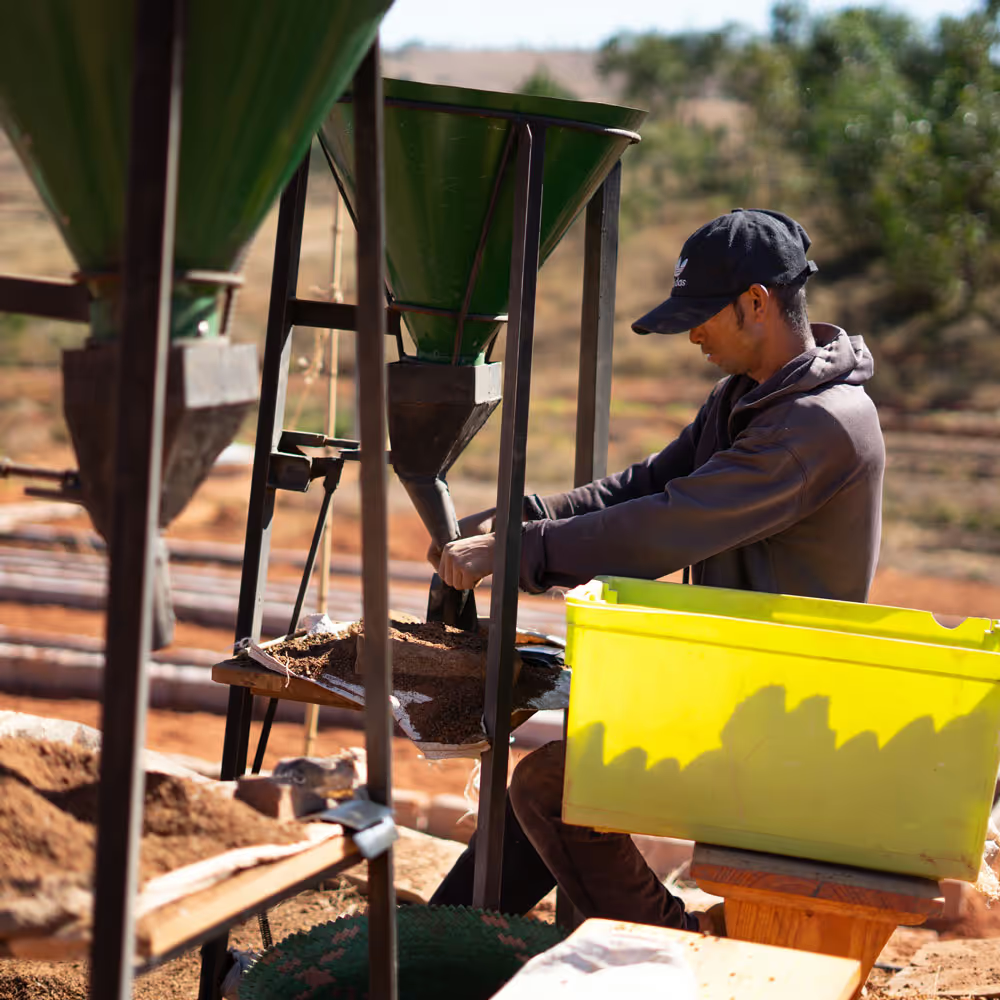Growing Native Trees and Shrubs
We grow seeds and cuttings in our own tree nursery until they are planted in the forests to be restored.

Progress in the tree nursery
We started building the tree nursery in Fihaonana in August 2023 and have made significant progress so far.

Last remnants of forest as a source of hope
In the entire 7'593 km² district of Ankazobe, there are no longer any public forests. But there is still hope: small forest remnants of the original forests, which often consist of only a few trees. This is exactly where all the seeds and cuttings from our tree nursery come from.
Seeds and cuttings come from forest remnants 50 km away
Distribution of critically endangered plant species
Freshly harvested seeds with a high survival rate
High biodiversity
Cooperation with local seed collectors

120 native plant species
From five plant species that are critically endangered and only exist in the Ankafobe Special Reserve, to threatened palm trees, precious pink or black woods and wild coffee (Kafeala) - nature in the Ankazobe District is magnificent!








More individuals in our nursery than in the wild
The Memecylon minimifolium tree species has been considered extinct since 1932. In 2016, a single specimen was rediscovered by local botanists in Ankazobe, which recently gifted us with 332 seeds. We at Kafeala are the only ones who are deliberately returning Memecylon minimifolium to the wild and thus making a fundamental contribution to its conservation.
Equally important is the tree species Schizolaena tampoketsana. There are 1'269 seedlings in our tree nursery, while according to the IUCN (International Union for Conservation of Nature and Natural Resources), there are only 340 fully-grown individuals left in the wild.

Vom Samen zur Jungpflanze
In 5 einfachen Schritten.
Samen im Keimbeet aussäen
Sobald der Samen in unserer Baumschule eintrifft, überprüfen wir seine Qualität. Ist er einwandfrei, wird er an der Sonne getrocknet und anschliessend in einem speziellen Keimbeet ausgesät.

Kompost herstellen
Gleichzeitig produzieren wir Kompost, den wir sowohl für die Pflanzenerde in den Säckchen als auch für die zukünftige Einpflanzung benötigen. Unser Kompost setzt sich aus Grünpflanzen und Stroh aus der Umgebung sowie Kuhdung zusammen.
Letzteren schaffen wir lastwagenweise heran, werden ihn jedoch in den kommenden Jahren schrittweise durch die Blätter mehrjähriger Pflanzen ersetzen, die wir Ende 2024 auf einer 19'000 m² grossen Fläche angepflanzt haben. Die eigene Kompostherstellung ist enorm kosteneffizient und schafft zusätzliche Arbeitsplätze in Fihaonana.

Pflanzensäckchen befüllen
Im nächsten Schritt wird das Pflanzensäckchen (8 × 12 × 5.5 cm) je zur Hälfte mit Erde und Kompost befüllt. Hierfür steht eine eigens entwickelte mechanische Vorrichtung zur Verfügung, die den Vorgang erheblich beschleunigt. Mit diesem System können bis zu dreimal mehr Säckchen befüllt werden, was einer Kapazität von bis zu 1'000 Stück pro Person und Tag entspricht.
Aus Gründen der Transparenz möchten wir darauf hinweisen, dass das Pflanzensäckchen aus dünnem Plastik besteht. Kompostierbare «Säckchen» in Madagaskar, deren effektive Abbaubarkeit wir nicht nachweisen können, würden in unserem Massstab Mehrkosten von mehreren tausend Schweizer Franken verursachen. Das ist für uns zum jetztigen Zeitpunkt nicht tragbar.

Setzling ins Säckchen umsiedeln
Sobald der Samen im Keimbeet zu einem vierblättrigen Setzling herangewachsen ist, wird er behutsam in das vorbereitete Pflanzensäckchen umgesiedelt.

Jungpflanze pflegen
Bis zur Einpflanzung im wiederherzustellenden Wald wird die Jungpflanze regelmässig bewässert und gepflegt.
